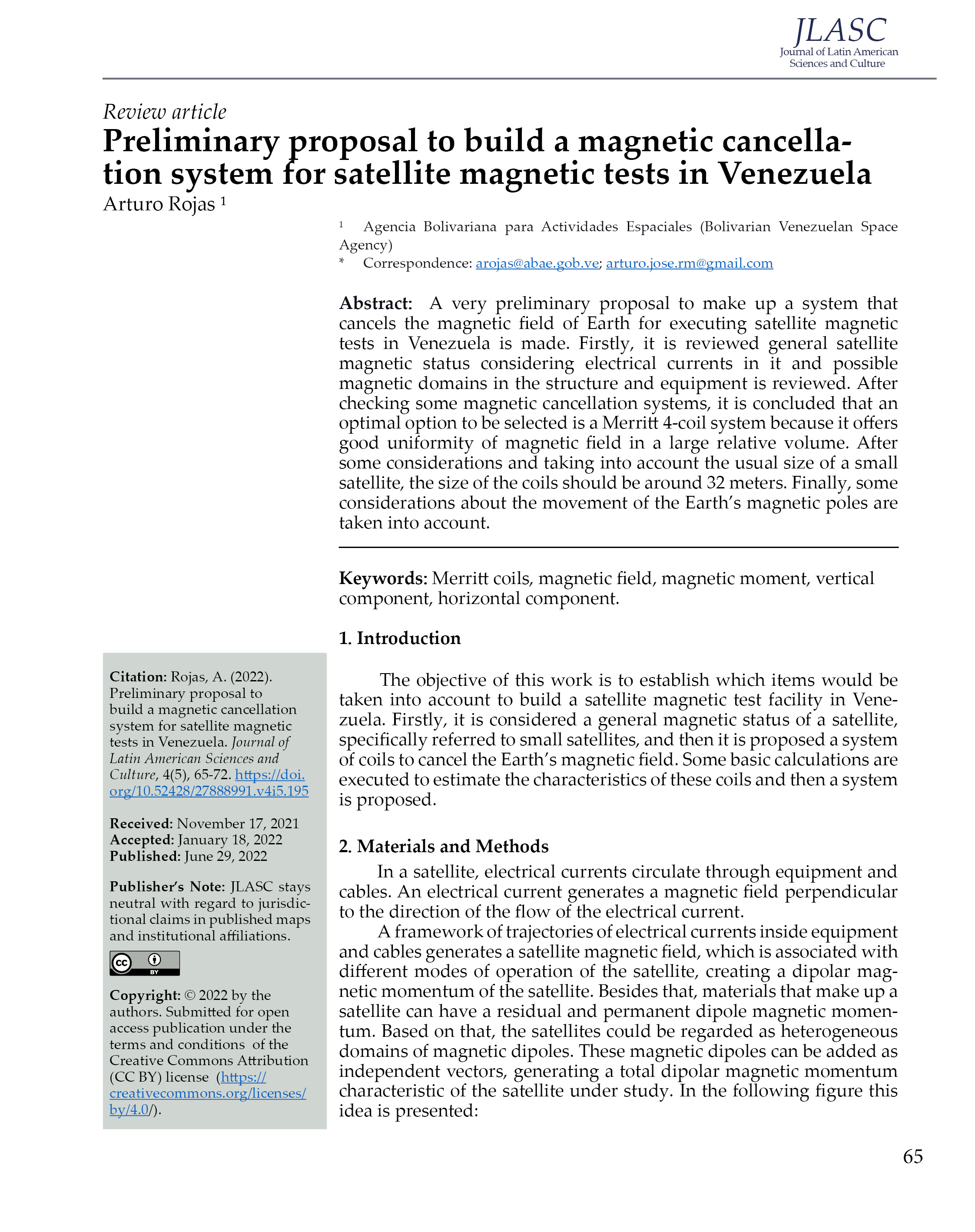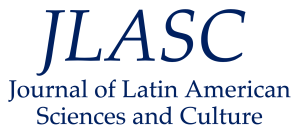Propuesta preliminar para construir un sistema de cancelación magnética para pruebas magnéticas satelitales en Venezuela
DOI:
https://doi.org/10.52428/27888991.v4i5.195Palabras clave:
Merritt coils, magnetic field, magnetic moment, vertical component, horizontal component.Resumen
Se hace una propuesta muy preliminar para conformar un sistema que cancele el campo magnético de la Tierra para ejecutar pruebas magnéticas satelitales en Venezuela. En primer lugar, se revisa el estado magnético general del satélite considerando las corrientes eléctricas en él y se revisan los posibles dominios magnéticos en la estructura y el equipo. Después de verificar algunos sistemas de cancelación magnética, se concluye que una opción óptima para ser seleccionada es un sistema Merritt de 4 bobinas porque ofrece una buena uniformidad del campo magnético en un gran volumen relativo. Después de algunas consideracioness y teniendo en cuenta el tamaño habitual de un smtodo satélite, el tamaño de las bobinas debe ser de alrededor de 32 metros. Finalmente, se tienen en cuenta algunas consideraciones sobre el movimiento de los polos magnéticos de la Tierra.
Descargas
Citas
Abbott, J. (2015). Parametric design of tri-axial nested Helmholtz coils. Review of Scientific Instruments, 86(5), 054701. https://doi.org/10.1063/1.4919400 DOI: https://doi.org/10.1063/1.4919400
Herceg, D., Juhas, A., & Milutinov, M. (2009). A design of a four square coil system for a biomagnetic experiment. Facta Universitatis - Series: Electronics and Energetics, 22(3), 285–292. https://doi.org/10.2298/fuee0903285h DOI: https://doi.org/10.2298/FUEE0903285H
IGRF Model (13th Generation). (2019). Retrieved from http://www.geomag.bgs.ac.uk/data_service/models_compass/igrf_calc.html
Kirschvink, J. (1992). Uniform magnetic fields and double-wrapped coil systems: Improved techniques for the design of bioelectromagnetic experiments. Bioelectro-magnetics, 13(5), 401–411. https://doi.org/10.1002/bem.2250130507 DOI: https://doi.org/10.1002/bem.2250130507
Lackey, M. (1968). Determining the Magnetism of Small Spacecraft. Presented at the The Challenge of the 1970, Cocoa Beach, USA: Scholarly Commons. Retrieved from https://commons.erau.edu/cgi/viewcontent.cgi?article=2705&context=space-congress-proceedings
Magdaleno, S., Olivares, J., Campero, E., Escalera, R., & Blanco, E. (2010). Coil System to Generate Uniform Magnetic Field Volumes. In Y. Rao (Ed.) (pp. 1–7). Presented at the COMSOL Conference 2010, Boston, USA: COMSOL Conference. Retrieved from https://www.comsol.com/paper/download/101163/olivares_paper.pdf
Mehlem, K. (1978). Multiple magnetic dipole modeling and field prediction of satellites. IEEE Transactions on Magnetics, 14(5), 1064–1071. https://doi.org/10.1109/tmag.1978.1059983 DOI: https://doi.org/10.1109/TMAG.1978.1059983
Merritt, R., Purcell, C., & Stroink, G. (1983). Uniform magnetic field produced by three, four, and five square coils. Review of Scientific Instruments, 54(7), 879–882. https://doi.org/10.1063/1.1137480 DOI: https://doi.org/10.1063/1.1137480
Pourtau, J., & Terral, M. (2005). Magnetic cleanliness verification of telecommunications satellite payload. In Y. Remillieux (Ed.). Presented at the European Test & Te-lemetry Conference, Toulouse, France: ETTC. Retrieved from http://web1.see.asso.fr/ettc2005/tocdrom/cdrom/pdf/EMC7.pd
Witze, A. (2019). Earth’s magnetic field is acting up and geologists don’t know why. Nature, 565(7738), 143–144. https://doi.org/10.1038/d41586-019-00007-1 DOI: https://doi.org/10.1038/d41586-019-00007-1

Archivos adicionales
Publicado
Cómo citar
Número
Sección
Licencia
Derechos de autor 2022 Journal of Latin American Sciences and Culture

Esta obra está bajo una licencia internacional Creative Commons Atribución 4.0.
Los autores/as que publiquen en esta revista aceptan las siguientes condiciones: Los autores/as conservan los derechos de autor y ceden a la revista el derecho de la primera publicación, con el trabajo registrado con la licencia de atribución de Creative Commons 4.0, que permite a terceros utilizar lo publicado siempre que mencionen la autoría del trabajo y a la primera publicación en esta revista. Los autores/as pueden realizar otros acuerdos contractuales independientes y adicionales para la distribución no exclusiva de la versión del artículo publicado en esta revista (p. ej., incluirlo en un repositorio institucional o publicarlo en un libro) siempre que indiquen claramente que el trabajo se publicó por primera vez en esta revista. Se permite y recomienda a los autores/as a compartir su trabajo en línea (por ejemplo: en repositorios institucionales o páginas web personales) antes y durante el proceso de envío del manuscrito, ya que puede conducir a intercambios productivos, a una mayor y más rápida citación del trabajo publicado.








